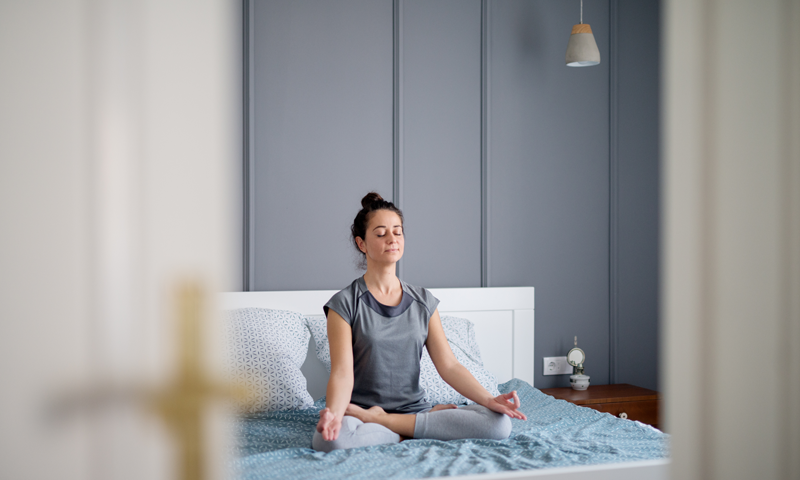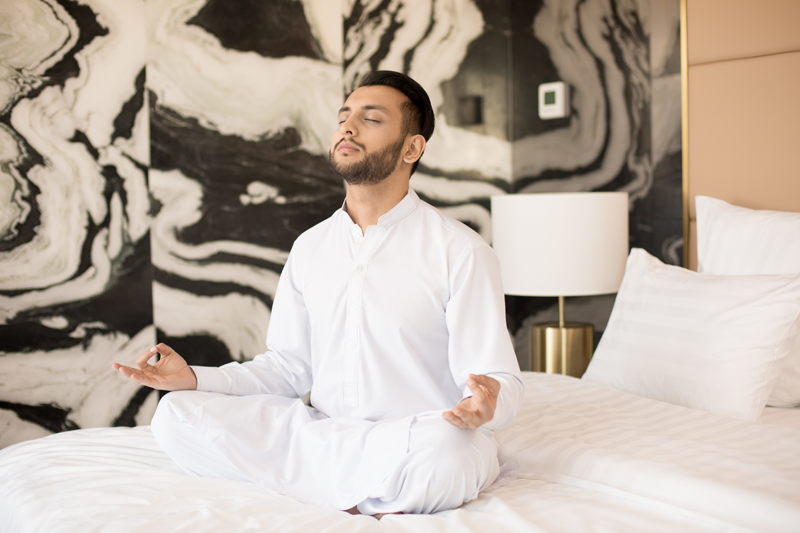
Yoga for Neck and Shoulder Pain
19th July 2019
What is Mantra Meditation and How to Do it
25th July 2019How to Meditate Before Bed

You’ve probably heard about the physical and mental health benefits of meditation. When used regularly, the practice can reduce stress, enhance concentration, lower your blood pressure, and improve your sleep. If you suffer from insomnia or restless sleeping, you may find it helps to put on your yoga pants and meditate before bed. In addition to reducing stress, meditation can calm the body ready for a peaceful slumber. But how do you meditate before bed? In this article, we explore exactly that.
Finish Your Chores
Before sitting down to meditate, it’s important to get your chores out of the way. If you try to meditate before finishing your jobs, it will be much harder to switch off your brain and reap the benefits of the practice. Even if you do manage to switch off and reach a peaceful state, you’ll need to interrupt this by finishing your chores. For best results, meditation should be the last thing you do before your head hits the pillow.
Change into Comfy Clothing
To drift from meditation into a peaceful slumber, get ready for bed before meditating. Jump in the bath, clean your teeth, and remove your makeup. Once you’re all clean, change into some comfy clothes. Depending on your preference, this can either be yoga clothing or your regular pyjamas. There isn’t any meditation specific clothing, so just go with whatever you feel most comfortable in. Some people find that yoga clothes get them into the right mindset, while others feel more relaxed wearing a pair of loose-fitting pyjamas.
Minimise Distraction
The next step is to minimise distraction. Before settling down, let your family know that you’re planning to meditate and ask them for some ‘me time’. Hopefully, this will stop them from interrupting your practice. If you’ve got children, consider meditating once they’re asleep. This way, you can relax without the worry of your little ones needing you. It’s also important to minimise the noise around you. If your family are watching TV, retreat to a separate room and carry out your practice. While you may not feel as though the TV is distracting, you’ll be surprised at how much it annoys you once you get going.
Set the Scene
For best results, set the scene before sitting down to meditate. If possible, meditate in the room you feel most relaxed. For many people, this is their bedroom. Retreating to your safe space will allow the mind to relax and switch off. If possible, politely ask other people to leave you to it so you can practice in peace. If you share a room with your partner, this may not be feasible. In this case, ask your significant other to be as quiet as possible whilst you’re practising. Alternatively, invite them to meditate with you! To set the scene, fill your space with several cosy accessories. Many yogis go for soft blankets and fluffy pillows. If you like, light an incense stick or scented candle for a relaxing aroma. Finally, dim the lights and turn on some relaxing background music.

Choose a Technique
Now you’re all set up, the only thing left is to choose a technique. Below, we explore some of the most popular techniques for evening meditation.
Breathing Meditation
Breathing meditation is one of the best techniques for beginners. By simply watching your breath, this ancient technique gives the mind something to focus on. To practice breathing meditation, close your eyes and begin to observe your breath. Pay attention to how it feels as you draw air in through your nose, down into your lungs and back out again through your mouth. You don’t need to control or force your breathing in any way. Just watch. If your mind wanders, don’t panic or criticise yourself; this is normal – particularly amongst beginners. Gently bring your attention back to your breathing and continue.
Mindfulness Meditation
Mindfulness meditation allows you to be present in the moment by bringing your attention to the sensations of your body. To practice this technique, start by focusing on your breath. After a few minutes, allow yourself to become aware of other sensations within your body; for instance, how you’re sitting or where you feel tension, tingling, or ease. The goal of mindfulness meditation is to become a neutral observer. Try not to analyse or judge any thought that passes through your mind. Simply observe.
Mantra Meditation
Mantra meditation uses a sound, word, or phrase to focus the mind. The ancient Sanskrit word “om” is often used as a meditative mantra; however, you can repeat any sacred word or meaningful phrase that helps to relax your mind. To practice this technique, sit comfortably and close your eyes. When you’re ready, repeat your chosen mantra aloud or silently.
Empty Mind Meditation
Empty mind meditation allows you to be aware without any specific focus. To practice this technique, sit comfortably with your eyes closed and allow thoughts to come and go as they please. As they float around your mind, observe them without attachment or judgement.
Spiritual Meditation
Meditation can also be a spiritual practice. Some people meditate as a form of prayer – the form where God speaks rather than just listens. During spiritual meditation, many people experience guidance or inner wisdom once the mind is quiet. To practice this technique, meditate on a singular question until an answer comes. Once you’re satisfied, move onto the next point.
In Summary
So, there you have it – how to meditate before bed. For best results, remember to change into a yoga top or comfy pair of pyjamas before you begin. Providing that you follow the steps above, it shouldn’t be long before you see results!

